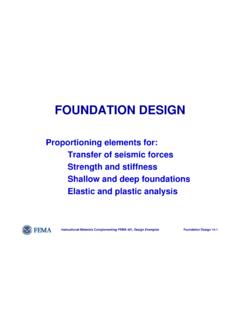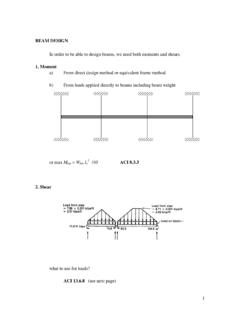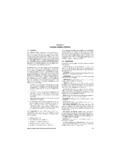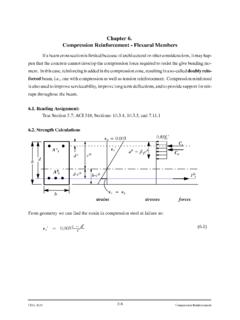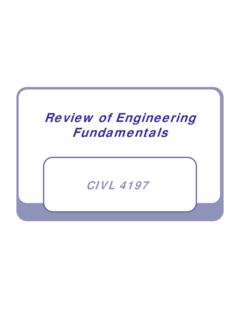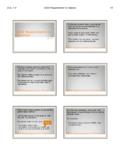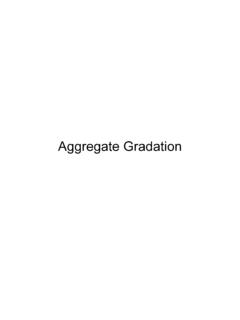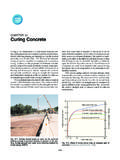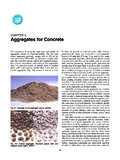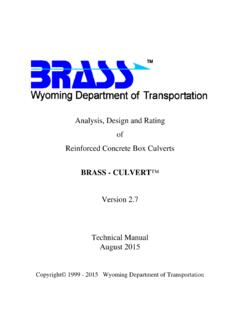Transcription of Chapter 13 Bridge Load Rating Contents - Civil Engineering
1 Bridge Design manual M Page 13-i May 2008 Chapter 13 Bridge load Rating General WSDOT Rating (LRFR) NBI Rating (LFR) Special Rating Criteria Dead Loads Live load Distribution Factors Reinforced Concrete Structures Concrete Decks Concrete Crossbeams In-Span Hinges Concrete Box Girder Structures Prestressed Concrete Girder Structures Concrete Slab Structures Steel Structures Steel Floor Systems Steel Truss Structures Timber Structures Widened or Rehabilitated Structures load Rating Software load Rating Reports Bibliography AAppendix Bridge Rating Summary 13-ii Bridge Design manual M May 2008 Contents Chapter 13 Bridge Design
2 manual M Page May 2008 Chapter 13 Bridge load GeneralBridge load Rating is a procedure to evaluate the adequacy of various structural components to carry predetermined live loads. The Bridge load Rating Engineer in the WSDOT Bridge Preservation Office is responsible for the Bridge inventory and load Rating of existing and new bridges in accordance with the NBIS and the AASHTO manual for Condition Evaluation of Bridges, latest edition. As presently required, only elements of the superstructure will be rated. Generally, the superstructure shall be defined as all structural elements above the column tops including drop order to provide a baseline Rating for new bridges, load ratings are required for all new bridges, widened (one lane width or more throughout the length of the Bridge ), or rehabilitated bridges where the rehabilitation alters the load carrying capacity of the structure.
3 The carrying capacity of a widened or rehabilitated structure shall equal or exceed the capacity of the existing Bridge Design Section does not load rate new bridges during the design phase. However, copies of the computer models used in the design process shall be submitted to the Bridge load Rating Engineer in the Bridge Preservation Section for the more complex structures where computer models were used in the design Bridge Preservation Office is responsible for maintaining an updated Bridge load Rating throughout the life of the Bridge based on current Bridge condition.
4 Conditions of existing bridges change over time, resulting in the need for reevaluation of the load Rating . Such changes may be caused by damage to structural elements, extensive maintenance or rehabilitative work, or any other deterioration identified by the Bridge Preservation Office through their regular inspection criteria applies only to concrete and steel bridges. For timber bridges, Rating procedure shall be as per Chapters 6 and 7 of the 1994 AASHTO manual for Condition Evaluation of elements as defined above shall be evaluated for flexural, vertical shear, and torsional capacities based on load Resistance Factor Design (LRFR) as outlined in the AASHTO 1989 Guide Specifications for Strength Evaluation of Existing Steel and Concrete Bridges and load Factor Design (LFD) as outlined in the latest AASHTO manual for Condition Evaluation of Bridges.
5 Consider all reinforcing, including temperature/distribution reinforcement, in the Rating definition, the adequacy or inadequacy of a structural element to carry a specified truck load will be indicated by the value of its Rating factor (RF); that is, whether it is greater or smaller than For a specific loading, the lowest RF value of the structural elements will be the overall Rating of the Bridge Design manual M May 2008 Bridge load Rating Chapter WSDOT Rating (LRFR) ratings shall be performed per the 1989 AASHTO Guide Specifications for Strength Evaluation of Existing Steel and Concrete Bridges.
6 All bridges, except timber, shall be rated based on the Strength Strength Method (LRFR) The basic Rating equations shall be: RFL1 IRDSnLDL!=+-ccU^h When Rating the full section of a Bridge , like box girders, or crossbeams, which have two or more lanes, the following formulas apply for the overload trucks: RFL1 IRDSL1 ILnDLLL egalLoad!=+--+cccU^^hh The formulas for the overloads assume that there is one overload truck in one lane, and legal trucks occupy the remaining lanes. Trucks shall be placed, in the lanes, in a manner that produces the maximum forces.
7 Factor (Ratio of Capacity to Demand)Rn=Nominal Capacity of SectionD=Calculated Dead LoadS=Secondary PrestressingL=Calculated Live load =Resistance Factor (Capacity Reduction Factor) DL=Dead load Factor. L=Live load Factor P=Prestress FactorI=Impact *For continuous structures, a one-half support width moment increase is to be used. Bridge Design manual M Page May 2008 Chapter 13 Bridge load RatingB. Service Method (LRFR) Prestressed and Post- tensioned Members Prestressed and post-tensioned members in positive moment regions, and where post-tensioning is continuous over the supports, shall also be rated based on allowable stresses at service loads.
8 The lowest Rating factors between Service and Strength methods shall be the governing Rating . The Rating equations shall be:Concrete Tension: I1 LLPPDLDLnM M M r I1 LLPPDLDLnV V V r I1 LLLoadLegalI1 LLPPDLDLnM M M M r I1 LLLoadLegalI1 LLPPDLDLnV V V V r S PDF FF S PDF FF I1L21 S PDFFF S PDF FF I1 LDLnL SD r L12550I Concrete Compression: I1 LLPPDLDLnM M M r I1 LLPPDLDLnV V V r I1 LLLoadLegalI1 LLPPDLDLnM M M M r I1 LLLoadLegalI1 LLPPDLDLnV V V V r S PDF FF S PDF FF I1L21 S PDFFF S PDF FF I1 LDLnL SD r L12550I Prestressing Steel.
9 I1 LLPPDLDLnM M M r I1 LLPPDLDLnV V V r I1 LLLoadLegalI1 LLPPDLDLnM M M M r I1 LLLoadLegalI1 LLPPDLDLnV V V V r S PDF FF S PDF FF I1L21 S PDFFF S PDF FF I1 LDLnL SD r L12550I = Rating Factor (Ratio of Capacity to Demand)Allowable Concrete Tensile Stress:FA=6 f c =3 f c for severe corrosive exposure=0 for members without bonded reinforcementAllowable Concrete compressive Stress:FA=6 f c = f c when checking live load plus one half of the dead and prestress compressive Prestressing Tensile StressFA= *y (Allowable Prestressing Tensile Stress) where f*y is the yield stress of the load StressFp=Stress due to Prestress Force after all lossesFS=Stress due to Secondary Prestress forcesFL(1+I)=Stress due to Live load including Impact For all loadings, prestress losses shall be per design or current Bridge Design manual .
10 For the overload trucks, the allowable stresses shall be increased by 15 Bridge Design manual M May 2008 Bridge load Rating Chapter 13 When the bending moment Rating for the overload vehicles is less than based on the Service Method, and greater than based on the Strength Method, the moment Rating shall be calculated by dividing the strength Rating factor by , and the result cannot exceed Timber Members I1 LLPPDLDLnM M M r I1 LLPPDLDLnV V V r I1 LLLoadLegalI1 LLPPDLDLnM M M M r I1 LLLoadLegalI1 LLPPDLDLnV V V V r S PDF FF S PDF FF I1L21 S PDFFF S PDF FF I1 LDLnL SD r L12550I Factor (Ratio of Capacity to Demand)FA=Allowable bending stressFD=Dead load StressFL=Stress due to Live load , does not include Impact FA is per AASHTO Standard Specs.
